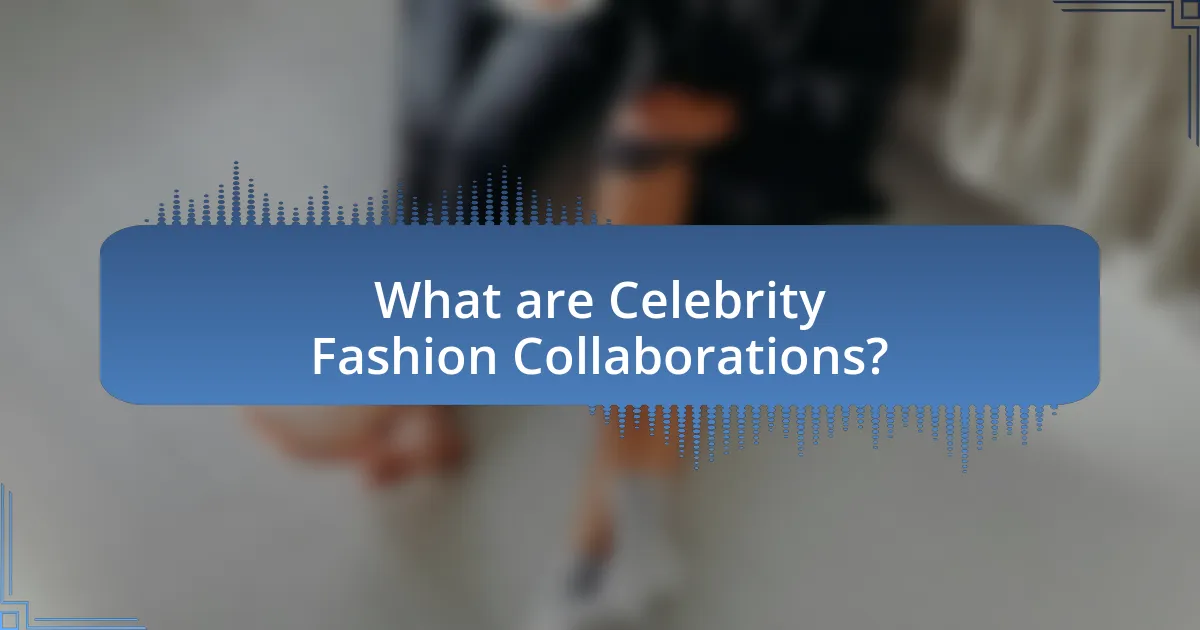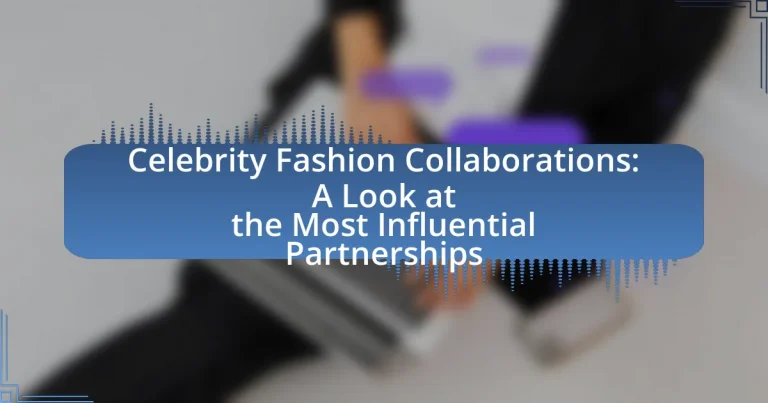Celebrity fashion collaborations are strategic partnerships between celebrities and fashion brands aimed at creating exclusive clothing or accessory lines. These collaborations leverage the celebrity’s influence to enhance brand visibility and drive sales, significantly impacting the fashion industry by shaping trends and consumer behavior. The article explores notable examples, such as Rihanna’s Fenty line with Puma and Kanye West’s Yeezy brand with Adidas, highlighting how these partnerships enhance brand perception, increase market reach, and drive revenue growth. Additionally, it discusses the key features of successful collaborations, the evolution of these partnerships, and the challenges brands face in navigating potential pitfalls.

What are Celebrity Fashion Collaborations?
Celebrity fashion collaborations are partnerships between celebrities and fashion brands to create exclusive clothing or accessory lines. These collaborations leverage the celebrity’s influence and fan base to enhance brand visibility and drive sales. For instance, Rihanna’s collaboration with Puma resulted in the highly successful Fenty line, which significantly boosted Puma’s market presence. Such partnerships often combine the celebrity’s unique style with the brand’s identity, resulting in products that appeal to both the celebrity’s followers and the brand’s customers.
How do Celebrity Fashion Collaborations influence the fashion industry?
Celebrity fashion collaborations significantly influence the fashion industry by driving trends, increasing brand visibility, and expanding market reach. These partnerships often result in limited-edition collections that generate buzz and consumer excitement, as seen with collaborations like Rihanna’s Fenty x Puma, which not only elevated Puma’s brand image but also set new trends in streetwear. Additionally, a study by the Harvard Business Review highlighted that celebrity endorsements can increase sales by up to 20%, demonstrating the tangible impact of these collaborations on consumer purchasing behavior. By leveraging the celebrity’s fan base and social media presence, brands can effectively tap into new demographics, thereby reshaping market dynamics and consumer engagement in the fashion sector.
What role do celebrities play in shaping fashion trends?
Celebrities play a significant role in shaping fashion trends by influencing public perception and consumer behavior through their visibility and style choices. Their appearances at events, social media presence, and collaborations with fashion brands create a ripple effect, often leading to increased demand for specific styles or items. For instance, when celebrities like Rihanna or Beyoncé wear particular designers or styles, it can lead to a surge in popularity and sales for those brands, as evidenced by the “Beyoncé Effect,” where her fashion choices directly impact market trends. This influence is further supported by studies showing that celebrity endorsements can increase consumer interest and purchasing intentions, highlighting their pivotal role in the fashion industry.
How do collaborations enhance brand visibility?
Collaborations enhance brand visibility by leveraging the established audiences of both partners, thereby increasing reach and engagement. When a brand collaborates with a celebrity or another brand, it taps into the celebrity’s fan base or the partner’s customer network, which can lead to a significant boost in exposure. For instance, a study by the Harvard Business Review found that brands that engage in collaborations can see a 20-30% increase in brand awareness due to the shared marketing efforts and cross-promotion strategies. This synergy not only amplifies visibility but also fosters credibility, as consumers often associate the collaborating brands with the positive attributes of their partners.
Why are Celebrity Fashion Collaborations significant?
Celebrity fashion collaborations are significant because they merge the influence of popular culture with the fashion industry, driving trends and consumer engagement. These partnerships often result in limited-edition collections that generate buzz and excitement, leading to increased sales and brand visibility. For instance, the collaboration between Rihanna and Puma revitalized the brand, resulting in a reported 20% increase in sales during the partnership. Additionally, celebrity endorsements can enhance brand credibility and attract a wider audience, as seen with Kanye West’s Yeezy line, which has consistently sold out upon release, demonstrating the power of celebrity influence in shaping consumer behavior.
What impact do these collaborations have on consumer behavior?
Celebrity fashion collaborations significantly influence consumer behavior by enhancing brand visibility and driving purchase intent. These partnerships often leverage the celebrity’s existing fan base, creating a sense of exclusivity and desirability around the products. For instance, a study by the Journal of Marketing Research found that collaborations can increase consumer engagement by up to 30%, as fans are more likely to purchase items endorsed by their favorite celebrities. Additionally, these collaborations often lead to increased social media buzz, further amplifying consumer interest and prompting immediate buying decisions.
How do collaborations affect the perception of brands?
Collaborations significantly enhance the perception of brands by associating them with the positive attributes of their partners. When a brand collaborates with a well-regarded celebrity or another reputable brand, it can leverage the celebrity’s influence and credibility to attract new customers and strengthen its image. For instance, a study published in the Journal of Marketing Research found that collaborations can lead to increased brand equity, as consumers often perceive collaborative products as more innovative and desirable. This perception shift occurs because the collaboration signals quality and exclusivity, making the brand more appealing to its target audience.

What are some notable examples of Celebrity Fashion Collaborations?
Notable examples of celebrity fashion collaborations include Rihanna’s partnership with Puma, which resulted in the successful Fenty x Puma line, and Beyoncé’s Ivy Park collaboration with Adidas, known for its inclusive sizing and bold designs. Additionally, Kanye West’s Yeezy brand, in collaboration with Adidas, has significantly influenced streetwear and sneaker culture. These collaborations have not only generated substantial sales but also reshaped fashion trends, demonstrating the powerful impact of celebrity influence in the fashion industry.
Which celebrities have made a significant impact through their collaborations?
Rihanna and Pharrell Williams have made significant impacts through their collaborations in the fashion industry. Rihanna’s partnership with Puma led to the successful Fenty x Puma line, which generated over $1 billion in sales and redefined athletic wear for women. Pharrell Williams’ collaboration with Adidas resulted in the highly popular NMD sneaker line, which contributed to a resurgence in the brand’s popularity and sold millions of pairs globally. These collaborations not only influenced fashion trends but also demonstrated the power of celebrity partnerships in driving brand success.
What are the key features of successful celebrity collaborations?
Successful celebrity collaborations are characterized by authenticity, mutual brand alignment, and effective marketing strategies. Authenticity ensures that the collaboration resonates with the celebrity’s personal brand and values, which enhances credibility and consumer trust. For instance, when Rihanna partnered with Puma, her genuine passion for sportswear and fashion led to a successful line that reflected her style and ethos. Mutual brand alignment is crucial; both the celebrity and the brand must share similar target audiences and values to create a cohesive partnership. Effective marketing strategies, such as leveraging social media and influencer networks, amplify the reach and impact of the collaboration, as seen in the success of the Adidas x Kanye West partnership, which utilized extensive social media campaigns to engage fans. These features collectively contribute to the success of celebrity collaborations in the fashion industry.
How have these collaborations evolved over time?
Celebrity fashion collaborations have evolved from simple endorsements to complex partnerships that integrate design and marketing strategies. Initially, celebrities primarily served as brand ambassadors, promoting existing products without significant input in the design process. Over time, these collaborations have transformed into co-creative ventures, where celebrities actively participate in the design and development of collections, reflecting their personal style and cultural influences. For example, the partnership between Rihanna and Puma in 2015 marked a significant shift, as it involved Rihanna’s direct involvement in the creative direction, leading to the successful Fenty line. This evolution is evidenced by the increasing number of collaborations that prioritize authenticity and storytelling, allowing celebrities to connect more deeply with consumers and influence fashion trends.
What brands have successfully partnered with celebrities?
Nike has successfully partnered with celebrities, including athletes like Michael Jordan and entertainers like Travis Scott. These collaborations have resulted in iconic products such as the Air Jordan line, which generated over $3 billion in revenue in 2020 alone, and the Travis Scott x Nike Air Force 1, which sold out instantly upon release. Other notable brands include Adidas, which has collaborated with Kanye West on the Yeezy line, achieving sales of over $1.3 billion in 2020. Additionally, Puma’s partnership with Rihanna has revitalized the brand, leading to a reported 13% increase in sales in 2016. These partnerships illustrate the significant impact of celebrity endorsements on brand success and revenue growth.
How do these partnerships align with brand identity?
Partnerships in celebrity fashion collaborations align with brand identity by enhancing brand visibility and credibility through association with influential figures. For instance, when a luxury brand collaborates with a well-known celebrity, it taps into the celebrity’s fan base, thereby reaching a wider audience that resonates with the brand’s values. This alignment is evident in collaborations like Rihanna’s Fenty Beauty, which emphasizes inclusivity and diversity, mirroring the brand’s commitment to these principles. Such partnerships not only reinforce the brand’s image but also create a narrative that connects emotionally with consumers, ultimately driving brand loyalty and sales.
What strategies do brands use to leverage celebrity influence?
Brands leverage celebrity influence through strategic partnerships, endorsements, and co-branded products. These strategies capitalize on the celebrity’s reach and credibility to enhance brand visibility and consumer trust. For instance, brands like Adidas have collaborated with celebrities such as Kanye West, resulting in the Yeezy line, which generated over $1.3 billion in revenue in 2020 alone. Additionally, social media campaigns featuring celebrities can significantly increase engagement; a study by Nielsen found that 70% of millennials are influenced by celebrity endorsements in their purchasing decisions. By aligning their products with well-known figures, brands effectively tap into the celebrity’s fan base, driving sales and brand loyalty.

How do Celebrity Fashion Collaborations affect the market?
Celebrity fashion collaborations significantly boost market visibility and sales for brands. These partnerships leverage the celebrity’s influence and fan base, leading to increased consumer interest and engagement. For instance, when Rihanna launched her Fenty Beauty line in collaboration with LVMH, it generated over $100 million in sales within its first few weeks, demonstrating the financial impact of celebrity endorsements. Additionally, a study by the Harvard Business Review found that brands collaborating with celebrities experienced a 20% increase in sales compared to those that did not. This illustrates how celebrity partnerships can effectively drive market growth and enhance brand equity.
What trends have emerged from recent collaborations?
Recent collaborations in celebrity fashion have led to the emergence of several key trends, including the rise of sustainable fashion, the blending of high fashion with streetwear, and the increasing use of digital platforms for marketing and sales. Sustainable fashion has gained traction as celebrities partner with eco-conscious brands, reflecting a growing consumer demand for environmentally friendly products. The fusion of high fashion and streetwear is evident in collaborations that combine luxury aesthetics with casual styles, appealing to a broader audience. Additionally, the use of social media and e-commerce platforms has become essential for promoting these collaborations, allowing for direct engagement with fans and consumers, as seen in partnerships like those between Rihanna and Puma or Beyoncé and Adidas.
How do collaborations drive sales and revenue for brands?
Collaborations drive sales and revenue for brands by leveraging the combined influence and reach of partnering entities, which enhances brand visibility and attracts new customer segments. For instance, when a celebrity collaborates with a fashion brand, their established fan base often translates into increased consumer interest and purchasing behavior. A notable example is the collaboration between Rihanna and Puma, which resulted in a reported 30% increase in sales for the brand during the partnership period. This synergy not only boosts immediate sales but also fosters long-term brand loyalty and recognition, as consumers associate the brand with the celebrity’s image and lifestyle.
What are the long-term effects of these partnerships on the fashion market?
The long-term effects of celebrity fashion partnerships on the fashion market include increased brand visibility, enhanced consumer engagement, and the establishment of new market trends. These collaborations often lead to a significant rise in sales, as evidenced by the 2019 collaboration between Adidas and Beyoncé, which resulted in a reported 30% increase in sales for the brand. Additionally, such partnerships can create lasting brand loyalty, as consumers often feel a personal connection to the celebrity involved, driving repeat purchases. Over time, these collaborations can also influence the overall direction of fashion trends, as seen with the rise of streetwear, which has been heavily shaped by celebrity endorsements and collaborations.
How can brands effectively engage in Celebrity Fashion Collaborations?
Brands can effectively engage in Celebrity Fashion Collaborations by strategically selecting celebrities whose personal brand aligns with their values and target audience. This alignment ensures authenticity, which is crucial for consumer trust and engagement. For instance, when Adidas collaborated with Kanye West for the Yeezy line, the partnership resonated with both the artist’s fan base and Adidas’ market, resulting in significant sales and brand visibility. Additionally, brands should leverage social media platforms to amplify the collaboration, utilizing the celebrity’s influence to reach a broader audience. According to a study by the Harvard Business Review, collaborations with well-aligned celebrities can increase brand equity by up to 20%. This demonstrates that effective engagement in celebrity collaborations hinges on strategic alignment, authenticity, and leveraging social media for maximum impact.
What best practices should brands follow when selecting a celebrity partner?
Brands should prioritize alignment between their values and the celebrity’s public persona when selecting a celebrity partner. This alignment ensures authenticity, which is crucial for effective marketing. For instance, a study by the Journal of Advertising Research found that 70% of consumers are more likely to purchase from brands that align with their values. Additionally, brands should consider the celebrity’s audience demographics to ensure they reach their target market effectively. Research indicates that partnerships with celebrities who resonate with the brand’s audience can increase engagement by up to 50%. Lastly, evaluating the celebrity’s past collaborations and reputation can help brands avoid potential controversies that could harm their image.
How can brands measure the success of their collaborations?
Brands can measure the success of their collaborations through key performance indicators (KPIs) such as sales growth, brand awareness, and social media engagement. Sales growth can be tracked by comparing revenue before and after the collaboration, providing a clear metric of financial impact. Brand awareness can be assessed through surveys and media coverage, indicating how well the collaboration has resonated with the target audience. Social media engagement metrics, including likes, shares, and comments, offer insights into consumer interest and interaction with the collaboration, reflecting its overall effectiveness in reaching and engaging the audience.
What are the challenges faced in Celebrity Fashion Collaborations?
Celebrity fashion collaborations face several challenges, including brand alignment, creative differences, and market reception. Brand alignment is crucial, as mismatched values between the celebrity and the fashion brand can lead to consumer confusion and backlash. Creative differences often arise when celebrities have distinct personal styles that may not align with the brand’s aesthetic, resulting in conflicts during the design process. Additionally, market reception can be unpredictable; collaborations may not resonate with the target audience, leading to poor sales performance. For instance, a collaboration that fails to connect with consumers can result in significant financial losses for both the celebrity and the brand involved.
How can brands navigate potential pitfalls in partnerships?
Brands can navigate potential pitfalls in partnerships by establishing clear communication and aligning goals with their partners. Effective communication ensures that all parties understand expectations, responsibilities, and objectives, reducing the likelihood of misunderstandings. Aligning goals helps in creating a unified vision, which is crucial for successful collaborations. For instance, a study by the Harvard Business Review highlights that 70% of partnerships fail due to misalignment of objectives. By prioritizing these strategies, brands can mitigate risks and enhance the effectiveness of their partnerships in the context of celebrity fashion collaborations.
What are the risks associated with celebrity endorsements?
The risks associated with celebrity endorsements include potential damage to brand reputation, financial loss, and legal issues. When a celebrity involved in an endorsement faces scandals or negative publicity, it can lead to a backlash against the brand, as seen in cases like the fallout from Tiger Woods’ personal controversies, which negatively impacted brands he endorsed. Financially, if the celebrity’s appeal wanes or if the partnership does not resonate with consumers, the investment may not yield a return, exemplified by the decline in sales for brands after high-profile endorsements fail to connect. Additionally, legal risks can arise from false advertising claims or contractual disputes, as highlighted by various lawsuits in the industry where brands faced penalties for misleading endorsements.
What tips can brands consider for successful collaborations?
Brands should prioritize alignment in values and target audiences for successful collaborations. Ensuring that both brands share similar missions and appeal to the same demographic enhances authenticity and engagement. For instance, when Adidas collaborated with Beyoncé, both brands focused on empowerment and inclusivity, which resonated with their shared audience. This strategic alignment not only maximized reach but also fostered a genuine connection with consumers, leading to increased sales and brand loyalty.


